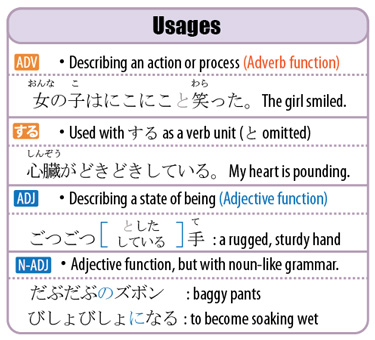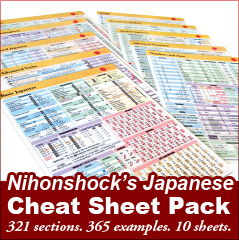Japanese Onomatopoeia
Onomatopoeia. That’s a big scary term with a much less daunting meaning: any word that mimics a sound. In English, onomatopoeia consists of words like “boom”, “pop”, and “cock-a-doodle-do”.
Of course, Japanese also has onomatopoeia (which they call
Even a certain lightning-wielding, yellow mouse character’s name turns out to be a simple fusion of sounds which means “sparkle-squeak” (actually, I think I like the English name better…). Anyway, my point is there’s so much onomatopoeia in Japanese that it will make your head spin (the sound for dizziness would be くらくら, by the way).
In fact, Japanese has so much onomatopoeia that they use them to describe all sorts of things, many of which (like dizziness) don’t actually make a sound. Maybe that seems strange, but we have some very similar words in English too, for example “dilly-dally” or “wishy-washy”. Just try to imagine if there were literally hundreds of words like that, and that on a given day you’d probably hear, read or use at least 50 of them.
Yet despite how common onomatopoeia are and how important they are for things such as casual conversation or reading fiction, they seem to be regarded as irrelevant by a lot of teachers and teaching materials. Common ones are taught as adverbs and that’s about it. The common perception among native Japanese speakers is that these words are “easy” because all they do is convey a sound. No kanji = easy.
Well I’ve got news for the native speakers: these words are NOT easy and they DO require special attention. It’s exactly because these words are not tied to kanji that they take on multiple, sometimes unrelated meanings and develop their own peculiar nuances and usage quirks (I seem to remember Japanese speakers complaining about this aspect of English vocabulary, no?). No kanji = less restrictions on usage = more vagueness and confusion.
In this article, I’m going to attempt to give readers a framework for understanding and using onomatopoeia.
Onomatopoeia Forms
The first thing that you need to know is that there are three basic forms an onomatopoeia can take.
Not all words can take all the forms (the three examples above are actually more flexible than most). Also, sometimes different forms of the same onomatopoeia will have somewhat different meanings, though they are usually either the same or strongly related. The important thing is just to be aware that onomatopoeia in Japanese (when used in a sentence) appear in one of these forms.
The second thing to know is that the particle you should associate with onomatopoeia is と. One of と’s primary functions is to mark quoted speech, such as in:
kare wa “konnichiwa” to itta.
He said “hello”.
But と also describes sounds in exactly the same way:
kare wa gokugoku to nonda.
He drank making a gulping sound.
In fact, the と in the TO-ending words above (にこっと、にやっと、こそっと) is the particle と. The particle is actually built into the form (therefore, don’t add any other particle when you use them).
The Double and RI forms of onomatopoeia are trickier, as each word has its own usage nuances. Some words will almost always come with a と, some will always omit their と. As I’ll explain later, some words are even treated similar to nouns and can be used with particles like の and に, but the basic rule of thumb is: the particle to use with an onomatopoeia is と (even though it is often omitted).
Pseudo-Onomatopoeia
One of the things that complicates the issue of learning onomatopoeia is that in addition to words like ちょっと and ゆっくり, which are so common that we don’t really think of them as onomatopoeia, there are also words that sound like and which may even be used like onomatopoeia, but aren’t.
You probably know a couple of these already too: いろいろ is an example. For all intents and purposes, you could consider this word an onomatopoeia, but its meaning is derived from the kanji (
Since these words aren’t really onomatopoeia, you have to be much more careful about which particle you select (if any). The above-mentioned three can all optionally take と, but others such as まだまだ(
And Japanese has one other another kind of fake onomatopoeia which is made by doubling adjective or verb stems (~I form). The meaning of the resulting word is dependent on the stem, so usually these aren’t too hard to figure out. For example,
*: there is one exception that I know of: のびのび (
Using Onomatopoeia
Okay, so now that you kind of have an idea what exactly an onomatopoeia is in Japanese, it’s time to look at how to use them.
There’s four basic usage patterns that you will find onomatopoeia in:
The reason onomatopoeia exist and the reason we use them is to describe. But essentially there are two and only two things which onomatopoeia can describe: either an action/process or a condition/state of being.
Which kind of description you are making affects the grammar you will need, hence I have distinguished between “adverb” (describing an action/process) and “adjective” (describing the state/condition of something) functions.
Individual onomatopoeia can be tightly restricted to one certain usage, or they can have multiple meanings each with a different usage, or they can have one core meaning that can be applied both ways. This can be a headache for learners, but only if you take it too seriously. Onomatopoeia are supposed to make sentences more colorful, to add emotion and spice. They’re fun! Without onomatopoeia, Japanese might as well be just one boring newspaper article about stock prices and exchange rates. But anyway, back to the topic…
The ADVERB usage (describing an action) is the default function of an onomatopoeia and also the simplest. It’s simple because you just stick it in front of the verb you’re describing, and decide whether or not to use と. Some words will require it, but in most cases it’s optional.
In cases where it’s optional, adding the と helps bring out the aural aspect of the word, so it’s less common in everyday speech and more common in creative writing. Including と also helps prevent word-order confusion if there’s something between your onomatopoeia and your verb.
The ADJECTIVE usage (describing an object/condition) is actually a specialized application of an adverb. Grammatically speaking, the onomatopoeia wants to be an adverb, so we need to do some linguistic acrobatics to make it modify a noun.
How do we turn an adverb into an adjective? We “format” it with either とした or している. Don’t concern yourself with the meaning of とした/している here because there really isn’t one, we’re just using the formless verb する as an intermediary between our onomatopoeia and our noun.
とした is kind of the “correct” way to make an adjective usage, and している (usually abbreviated to してる) is the “casual” way, but they’re both doing the same thing: taking a sound and “formatting” it so that it can modify a noun.
Because constantly “formatting” onomatopoeia is kind of inconvenient, a lot Adjective-natured onomatopoeia have developed a different usage. An Onomatopoeia with a N-ADJECTIVE usage can be used similarly to a noun. “N” is the perfect letter to represent these words, not only because they have some similarities to nouns, but because by happy coincidence they are mostly used with the particles の and に (and sometimes even な, like a NA-Adjective).
Note that although these words have some grammatical similarities to nouns, it usually doesn’t make any sense to use them as objects (を). And if you find them with で , it’s probably actually the TE-form of だ/です, not the particle で.
The SURU usage is very handy. You simply pair the onomatopoeia with the “formless” verb する, and the resulting verb means “to act/feel/occur/be” in whatever way is described by the onomatopoeia. So for example, くらくら which I mentioned at the beginning of the article describes dizziness and is used with する. The typical usage of this is:
atama ga kurakura shiteru.
My head is spinning.
One important thing to note about the SURU usage of onomatopoeia is it usually only makes intransitive verbs (verbs which don’t take objects). To make these verbs transitive, you need to use the causative form: させる. Therefore:
トムの
Tom no atama o kurakura saseta.
I made Tom’s head spin.
Sure, you could consider these to be adverbs. But if an adverb (such as どきどき) is used almost exclusively to describe one particular verb (する), and that verb is basically meaningless, wouldn’t it be more helpful just to think of it as a verb unit?
Common Double-form Onomatopoeia
| Onomatopeia |
Usage | Meaning |
| いらいら | SURU | to be edgy/testy, ticked off |
| うろうろ | SURU | to wander about aimlessly, loiter |
| きらきら | (various) | shining/sparkling/glitter |
| くすくす | ADV | laughing/chuckling (quietly/bashfully) |
| ぐずぐず | SURU | To act lazy, slow, procrastinate |
| くるくる | (various) | spinning/turning – curly (hair) |
| こそこそ | ADV/SURU | (speaking) secretively, quietly |
| ぬるぬる | ADJ | wet and slippery, slimy |
| ねばねば | ADJ | sticky |
| じろじろ | ADV | staring fixatedly |
| じわじわ | ADV | steadily, without haste |
| すらすら | ADV | unimpeded, continuous, sleek |
| ぞくぞく | SURU | feeling a thrill/adrenaline rush |
| もじもじ | SURU | acting antsy/squirmy |
| ばたばた | ADV/SURU | busy, hurried, rushing from place to place |
| びくびく | SURU | to twitch, spasm |
| ふらふら | ADV/SURU | woozy/unstable, swaying from side to side |
| ぼろぼろ | N-ADJ | ripped up (clothing), worn out, beat up |
| わくわく | SURU | to get nervous/anxious with anticipation |
Common RI- and TO-form Onomatopoeia
| Onomatopoeia | Usage | Meaning |
| がっかり | SURU | to be disappointed/let down |
| しっかり | (various) | firm/steadfast |
| たっぷり | (various) | more than enough/required |
| はっきり | ADV/SURU | clearly, plainly |
| ゆっくり | ADV | slowly |
| きっと | ADV | surely, without a doubt |
| じっと | ADV/SURU | without moving/motionless |
| ちゃんと | ADV | properly, correctly, obediently |
| ちょっと | ADV | a little bit, somewhat |
| ぼーっと | ADV/SURU | to space out, be distracted |
| もっと | ADV | more |
Onomatopoeia Cheat Sheet
If you are interested in improving your onomatopoeia, check out Nihonshock’s digital “Onomatopoeia” cheat sheet. It contains 340 onomatopoeia and pseudo-onomatopoeia, complete with usage notes, alternate forms, synonyms, and more.
Get it for $2.50, about the price of a cup of coffee.











[…] Sources: Japanese Onomatopoeia […]
[…] Sources: Japanese Onomatopoeia […]
[…] Tofugu has the ultimate guide on onomatopoeia, but if you’d like a more concise overview you can also check out RocketNews24 or Nihonshock. […]